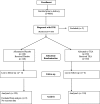A double-blind, randomized controlled trial to explore oral tranexamic acid as adjunct for the treatment for postpartum hemorrhage
- PMID: 32143721
- PMCID: PMC7060559
- DOI: 10.1186/s12978-020-0887-2
A double-blind, randomized controlled trial to explore oral tranexamic acid as adjunct for the treatment for postpartum hemorrhage
Abstract
Background: Oral tranexamic acid (TXA), if effective in reducing blood loss after delivery for women experiencing primary PPH, could be administered where parenteral administration is not feasible. This trial assessed the efficacy, safety, and acceptability of oral TXA when used as an adjunct to sublingual misoprostol to treat postpartum hemorrhage (PPH) following vaginal delivery.
Methods: From October 2016 to January 2018, women presenting at four hospitals in Senegal and Vietnam for vaginal delivery were screened for enrollment in the trial. Women diagnosed with postpartum hemorrhage (defined as blood loss ≥700 ml) were randomized to receive either oral TXA (1950 mg) or placebo in addition to 800 mcg sublingual misoprostol. Postpartum blood loss was measured using a calibrated drape. Blood loss for all PPH cases was recorded for 2 h after administration of the drugs. The primary outcome measure was the proportion of women with bleeding controlled with the trial regimen without recourse to further treatment. Secondary outcomes including the rate of severe PPH, mean/median blood loss, use of additional uterotonics and/or interventions side effects, and acceptability were also recorded.
Results: Of the 258 women who received treatment for PPH, 128 received placebo and misoprostol and 130 received TXA and misoprostol. The proportion of women who had active bleeding controlled with trial drugs alone and no additional interventions was similar in both groups: 77(60.2%) placebo; 74 (56.9%) TXA, p = 0.59). Use of other interventions to control bleeding, including uterotonics, did not differ significantly between groups. Median blood loss at PPH diagnosis was 700 ml in both groups. Uterine atony alone or in addition to another cause contributed to over 90% of PPH cases reported (92.2% placebo vs. 91.5% TXA), other causes included perineal and cervical lacerations and retained placenta. Reports of side effects and acceptability were similar in the two groups.
Conclusion: Adjunct use of oral TXA with misoprostol to treat PPH resulted in similar clinical and acceptability outcomes when compared to treatment with misoprostol alone.
Trial registration: This trial was registered with ClinicalTrials.gov, number NCT02805426. Registered on 3 September 2016.
Keywords: Misoprostol; Postpartum hemorrhage (PPH); Tranexamic acid.
Conflict of interest statement
The authors declare that they have no competing interests.
References
-
- Department of Reproductive Health and Research. World Health Organization . WHO recommendations for the prevention and treatment of postpartum haemorrhage. WHO Library Cataloguing-in-Publication Data NLM classification. 2012. - PubMed
Publication types
MeSH terms
Substances
Associated data
Grants and funding
LinkOut - more resources
Full Text Sources
Medical


